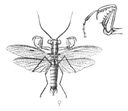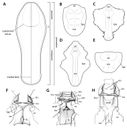Little Yucatan Mantid
Mantoida maya
Classification
- Phylum: Arthropoda
- Subphylum: Hexapoda
- Class: Insecta
- Order: Mantodea
- Family: Mantoididae
- Genus: Mantoida
- Species: maya
Pronunciation
How to pronounce Mantoida maya: /mænˈtoʊɪdə ˈmaɪə/
These audio files are automatically generated. While they are not always 100% accurate, they are a good starting point.
Images




Summary
Mantoida maya, commonly known as the little Yucatán mantis, is a species of praying mantis found in Mexico and Florida. It exhibits unique juvenile mimicry and distinct physical characteristics.
Physical Characteristics
15-17 mm in length; juvenile mimics ants and wingless ichneumon wasps (red head & thorax, black abdomen); square-shaped pronotum; oval abdomen with white bands on the first 2 abdominal tergites; white bands on the antennae.
Identification Tips
Look for the square-shaped pronotum and the unique color pattern, especially the resemblance to ants and ichneumon wasps in juveniles.
Habitat
Open pinelands, scrub; ground litter in hammocks and thickets of dense scrub.
Distribution
Found in Mexico and the U.S. state of Florida.
Life Cycle
Adults are typically active from June to September.
Tags
- Mantoida maya
- Little Yucatán mantis
- praying mantis
- insect
- Florida